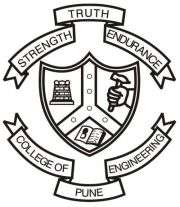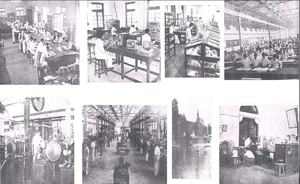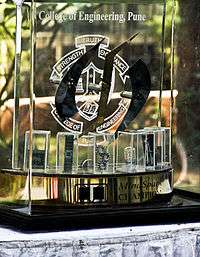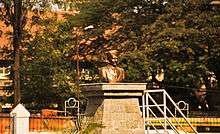College of Engineering, Pune
 | |
Former names |
Poona Engineering and Mechanical School (1854 - 1864) Poona Civil Engineering College Poona College of Science Government College of Engineering, Poona |
|---|---|
| Motto |
Strength Truth Endurance |
| Type | Public |
| Established | 1854 |
| Chairman | Fakir Chand Kohli[1] |
| Dean | M. S. Sutaone |
| Director | B.B.Ahuja |
Academic staff | 20[1] |
Administrative staff | 400 |
| Students | 3,800 |
| Undergraduates | 2,800[1] |
| Postgraduates | 1000 |
| Address |
Wellesly Road Shivajinagar Pune 411 005, Shivajinagar, Pune, Maharashtra, India |
| Campus | Urban, 36.81 acres (currently under demarcation for development purpose) |
| Website | www.coep.org.in |
College of Engineering, Pune (COEP) is an autonomous engineering institute affiliated to Savitribai Phule Pune University in Pune, Maharashtra, India. Established in 1854, it is one of the oldest engineering colleges in Asia, after College of Engineering, Guindy Chennai (1794) and IIT Roorkee (1847)...[2][3][4] The students and alumni of College of Engineering, Pune are colloquially referred to as COEPians.[5] The college's study model was referred to, in the early 1950s, as the "Poona Model".
College of Engineering, Pune is located at the confluence of the rivers Mula and Mutha.
History
The college was one of the first few colleges established by the British to serve the Indian subcontinent. The foundation stone of the new college was laid by the Governor of Bombay, Sir Bartle Frere, who was to become the Vice-Chancellor of the University, on 5 August 1865.[6][7][8] In June of the following year, Theodore Cooke M.A., was appointed the Principal. He went on to hold the office for next 28 years.[6][9]
Initially, It was started on December 16, 1854, to train public works department (PWD) officials and was housed in three bungalows as the ‘Poona Engineering and Mechanical School’ to train subordinate officers for carrying out public works like buildings, dams, canals, railways and bridges.[2][4][10][11][12] In July 1857, Henry Coke was given the charge of the institute.[13] Admission was open to all, irrespective of nationality or caste.[13] Good proficiency in English and basic knowledge of Mathematics were a prerequisite for getting admitted to the institute.[13] The process of admission required that the aspiring candidate apply to the nearest government English school, to whom the entrance examination papers were handed over.[13] The headmaster would take the examination on a date deemed convenient to him and submit the answer sheets to Henry Coke, the in-charge of the mechanical school.[13] After examining the papers, Coke would notify the headmaster of the school with the names of candidates who were deemed fit for admission. Scholarships of ₹6 were offered per month after a period of six months of training in the mechanical school for fifteen students. The courses offered included Mathematics, Drawing, Surveying and levelling, building and construction and setting out works on the ground.[13] The course would run for a period of two years.[13]
Later on, in the year 1864, the school became the "Poona Civil Engineering College". The number of courses were increased to include forestry and agricultural subjects, which led to its name being changed to Poona College of Science. The college was inaugurated at the new premises on August 5, 1865, at the hands of then governor Sir Bertel Ferre. It started a course in licensed and civil engineering (LCE) and trained masons and overseers. Later it secured affiliation to the Bombay university. The course was revised in 1886 and the minimum criteria required for admission was raised from Matriculation to the then Previous Examination.
In 1909, the LCE was converted into the BE degree and the first batch of students passed out in 1912. The name ‘Government college of engineering, Pune’ was taken up only in 1911. All non-engineering courses were stopped by 1911, transferring the Bachelor of Science degree to the Science Institute of Bombay and subsequently in the year 1911, the name was changed to the "Government College of Engineering, Poona".

The institution was initially affiliated to the University of Bombay (now Mumbai) for a degree of Licentiate in Civil Engineering known as LCE in 1858.[2][14] The certificate course was converted into a degree course and the first class of the Bachelor of Engineering degree graduated in the year 1912. After the University of Poona (now Savitribai Phule Pune University) was established in 1948, the college became affiliated to the new university. In 1968, the three-year degree was extended to 4 years constituting 8 semesters.
In 2003, the institute was granted complete autonomy by the State Government of Maharashtra, thus giving it the freedom to set its own curriculum and manage its own finances.[8] With permanent affiliation to the Savitribai Phule Pune University, the institute now is an autonomous engineering school. This has been the biggest change as far as pedagogy at COEP is concerned. The following years have seen a multitude of positive changes in administration and academic strategies. Many of these have been responsible for the growing innovation in project work of college students. The institute contends that its autonomy now grants it greater flexibility in dynamically changing its syllabus to suit the changing needs of the industry.
Accreditation
The National Board of Accreditation, has accredited all programmes under Tier-2 (General) status for a period of 5 years from 2012.[15] In the year 2014, 9 undergraduate programmes were accredited with tier-1 (Washington Accord) status. This particular accreditation gives way to recognition of the quality of undergraduate engineering education offered by the member country and is an avenue to bring it into the world class category. It encourages and facilitates the mobility of engineering graduates and professionals at international level.[16] The tier-1 accreditation is effective from 01/07/2014 for a period of five years.[17]
Architecture
The Main Hall
The main hall is the present day administrative building of the College. It houses the Director, the Dean Academic Affairs, the Dean Student Affairs, the Gymkhana, the Examination cell and other various important administrative heads of the college. The original building was almost three floors tall with a base floor length of 18 meters and a width of 9 metres. The hall was recently refurbished and the inauguration of the restored heritage building (pictured below) took place on 24 March 2012 by Sharad Pawar, Minister of Agriculture, Government of India.[18]
Admissions
Undergraduate
Undergraduate admissions to the College of Engineering, Pune are competitive and are based on merit.[19] Earlier admissions were based upon the percentage of science subjects' marks secured in Higher Secondary Certificate exam of Maharashtra state and later on the basis of marks scored in JEE-MAINS.[20][21] However, at present the admissions are conducted on the basis of the marks secured in JEE Mains and HSC board combined . These admissions are conducted by the Directorate of Technical Education (DTE) through the Centralized Admission Process(CAP). Affirmative action programs exist for students belonging to socially and economically backward classes as stipulated in the Constitution of India and various statutes. There are programs for students from north-eastern India and Indian citizens from Kashmir. There are also programs for children of people working in Gulf countries, foreign nationals, foreign students and Person of Indian Origin (PIO) in the college. Non-Resident Indians can also apply for the courses.For the year 2015-16 this quota is applicable for admissions to Walchand College of Engineering, Sangli and Laxminarayan Institute of Technology. The reservations for different categories are based on the Government of India and Government of Maharashtra rules. Reservations in seats are provided for SC (Schedule Caste), ST (Schedule Tribes), NT (Nomadic Tribes), OBC (Other Backward Classes), PH (Physically Handicapped) as well as female candidates. In addition to the admissions through CAP, people wear caps and come for the admission. It has been included in the Guinness Book of world records, several admissions to direct second year of B.Tech. course are also conducted for those candidates who have completed Diploma in Engineering at different polytechnic institutes in the state of Maharashtra. These admissions are conducted through the Centralized Admission Process (CAP) by DTE itself.[22]
Postgraduate and Doctorate
Postgraduate admissions to the College of Engineering, Pune are also on merit basis. The M.tech admissions are on the basis of the Graduate Aptitude Test in Engineering(GATE) conducted by the seven old IITs and the IISc. Seat reservations are applicable as per the Government of Maharashtra rules. The college also provides Doctor of Philosophy(Ph.D) programmes in various fields.[23] Department of Applied Sciences is recognised as Ph.D. research centre by S.P. Pune University in the subjects of Environmental Sciences and Chemistry.
Activities
COEP is the hub of various curricular, extra-curricular and technical activities which attracts participation and praise alike from numerous colleges in India.
MindSpark

MindSpark is the national level annual technical festival hosted by the college and established in 2007. The idea behind MindSpark originated from the need to unite various departmental level festivals that were scattered across the academic calendar. It features about 50 events across various disciplines of engineering and has been backed by the support of industrial sponsors who also associate with COEP for placement.This event is usually scheduled in an odd semester and is of 3 days(usually weekend).[24][25]
Regatta

The College of Engineering, Pune is among the few colleges in the world which hosts an annual regatta. Since its inception in 1928, it has showcased around 165 boats, notably the Eighter, which is one of the oldest boats.[26] The 89th edition of Regatta was held on 26 March 2017. Unlike a Regatta which means a collection of boat races, COEP Boat Club's Regatta is a show of various kinds of boats, kayaks, punts, shell boats and scull boats. The events in this show are Telematches, Kayak Ballet, Shell Games, Punt Formation, Mashaal Dance and the Arrow formation.[27]
Cultural activities
.jpg)
COEP has been one of the leading colleges from Pune in various cultural competitions like Firodiya Karandak, Purushottam Karandak, Mood Indigo (festival). In 2016, COEP held their first ever Cultural Fest Impressions.[28]
Sesquicentenary celebrations
In 2004, COEP celebrated 150 years of its existence.[8][29] The celebrations were marked by a visit by the Hon. Ex-President of India, Dr. APJ Abdul Kalam.[29] A postage stamp to mark the 150th anniversary of the college was released.[30]
Participation in Guinness World Records
The college has made three entries so far in the Guinness World Record books. It holds the record for "Most people skipping on the same rope", which still stands as the world record[31] and "The longest painting by numbers"[32]
On 4 November 2012, 3248 people solved the Rubik's cube at the same time for breaking the Guinness world record for "Most number of people solving the Rubik's cube". It was previously held by IITB, where 937 students solved the puzzle within 30 minutes in March 2012.[33][34]
Team Nemesis Racing (BAJA Competition)
Baja Competition is an event which comprises designing, fabricating, assembling an all-terrain four wheeler vehicle and running it on a specially prepared torturous track in a grueling competition for four hours.
The College team was declared the overall winner at the Baja SAE India contest 2013 held at Pithampur, near Indore at the National Automotive Testing and R&D Infrastructure Project.[35] The team also won the Best Acceleration, the Raftaar award, CAE(Computer Aided Engineering) award, Best Build Quality, Endurance winner awards.
BAJA 2015 witnessed COEP starting at the pole position in the race consecutively for the fourth time by being the fastest vehicle. COEP received a total of following 5 awards in BAJA competition 2015, Manoeuvrability - 1st Place, Sales Presentation - 1st Place, Design Evaluation - 2nd Place, Acceleration - 3rd Place, Overall Position - 4th Place
BAJA 2016 was held at Pithampur, Indore on 21 February 2016. COEP started at the pole position in the race consecutively for the fifth time by being the fastest vehicle. Out of the 14 award categories, COEP won 11 awards in BAJA competition 2016 retaining the Overall Championship.[36]
COEP team Nemesis won overall championship at BAJA 2017 competition creating a hatrick of records. In the 10th edition of Mahindra BAJA, a total of 415 entries applied for the event from 185 colleges that participated at a virtual stage, out of which 150 teams were selected for m- BAJA, while 35 teams for eBAJA. In the final round or the endurance test, 118 teams participated in the competition which was held from 16 to 21 February 2017 at the NATRIP facility in Pithampur, Indore. Out of the 12 award categories, COEP won 7 awards in BAJA competition 2017 retaining the Overall Championship.[37]
COEP robotics team
In 2017 the COEP robotics team won the national ABU Robocon and represented India in the international competition.[38]
Rankings
| College rankings | |
|---|---|
| General – India | |
| NIRF (Overall) (2018)[39] | 96 |
| Engineering – India | |
| NIRF (2018)[40] | 45 |
| Outlook India (2017)[41] | 10 |
COEP was ranked 10 among engineering colleges in India by Outlook India in 2017.[41] The National Institutional Ranking Framework (NIRF) ranked it 45 in the engineering ranking in 2018[40] and 96 overall.[39]
Notable alumni

- Baburao Govindrao Shirke, Founder of B. G. Shirke & Company[42]
- C. Kumar N. Patel, Vice Chancellor for Research at the University of California, Los Angeles, inventor of the carbon-dioxide laser, winner of the United States National Medal of Science[8]
- Mokshagundam Visvesvarayya (1861–1962), Bharat Ratna, eminent engineer and statesman[8]
- Nitin Paranjpe, President of the Foods & Refreshment Division of Unilever[43]
- Rajiv Bajaj, Managing Director of Bajaj Auto: One of the largest two-wheeler manufacturer in India[44]
- Ramesh Raskar, Associate Professor at Massachusetts Institute of Technology, Director of MIT Media Lab's Camera Culture group and developer of a high-speed femto-camera that captures pictures of light.[45]
- Sandeep Johri, technology executive and serial entrepreneur, CEO of Tricentis[46]
- Trimbak Parchure , former emeritus professor at COEP. M.S,PhD University of Florida, United States
- Thomas Kailath, emeritus professor of engineering at Stanford University, winner of the IEEE Shannon Award and US National Medal of Science[47]
- Vaibhav Tatwawaadi, actor in Marathi and Hindi films[48]
- Vijay Kelkar, Padma Vibhushan, Advisor to the Finance Minister, Government of India in the rank of a Minister of State, Chairman, National Stock Exchange of India[8]
- Aravind Joshi, emeritus professor of Computer and Cognitive Science at the University of Pennsylvania.
Controversies
Land acquisition
In December 2005 the Pune Municipal Corporation asked the college for some of its land for road widening. This led to considerable outrage amongst students, and the issue was under heated debate. It was pointed out that the college was classified as a 'heritage complex' by the state government.[49]
Renaming
1854–1870: Poona Engineering Class and Mechanical School[8][50]
1871–1911: Government Science College(Agriculture and Botany Classes)[8][50]
1911–2003: Government College of Engineering, Pune[8][50]
2003–2006: Pune Institute of Engineering and Technology[8]
2006 onwards: College of Engineering, Pune
In 2000, COEP claimed independence from the state government and was declared an autonomous institute in 2003.[7][8] Considerable confusion ensued over a proposed name change from COEP to Pune Institute of Engineering and Technology (PIET) which was strongly opposed by alumni and students. The newly autonomous entity's name was rolled back to COEP in November 2005.[51]
Road widening and flyover construction
The College was at loggerheads with the Pune Municipal Corporation over the proposed construction of a flyover in front of the college, that would not only deface the renovated Main Hall but would also encroach upon the College's premises. The College and its alumni were of the opinion that the flyover would not, in any way, decongest the traffic plying through that road.[52][53] It also considered the flyover as serious danger to the safety of the pedestrians, including students, as it was not considered in the plan of the flyover.[54] Many civic activists and organisations supported the College's opinion.[52][55][56]
See also
References
- 1 2 3 Mandatory, Disclosure. "Annexure A" (PDF). Disclosure regarding faculty, senate and other working details. College of Engineering, Pune. Retrieved 8 January 2012.
- 1 2 3 Henry Herbert Dodwell (1929). The Cambridge History of the British Empire. CUP Archive.
- ↑ College of Engineering, Pune, Official Website. "History". History of College. College of Engineering, Pune. Retrieved 9 December 2011.
- 1 2 A.A. Ghatol, S. S. Kaptan, A. A. Ghatol, K. K. Dhote (1 January 2004). Industry Institute Interaction. Sarup & Sons. pp. 61-. ISBN 978-81-7625-486-1.
- ↑ Shastri, Padmaja (4 April 2006). "'COEPians' discover alumni treasure move". Times of India. Retrieved 31 July 2014.
- 1 2 The Bombay University Calendar for the year 1866–67. pp. 152–.
- 1 2 India, PRwire (27 February 2008). "College of Engineering, Pune to Host Honeywell-Nobel Laureate Lecture Series". India PRwire. Archived from the original on 10 February 2012. Retrieved 21 December 2011.
- 1 2 3 4 5 6 7 8 9 10 11 Times of India, Newsletter (16 December 2004). "150 years of engineering excellence". Times of India. Retrieved 9 December 2011.
- ↑ Rheedea (2010). A Centennial Remembrance of Two Great Botanists (PDF). New Delhi: Department of Science and Technology, Government of India. pp. 135–136. Retrieved 9 January 2012.
- ↑ The Asiatic annual register; or, A view of the history of Hindustan,: and of the politics, commerce, and literature of Asia, ... Printed for J. Debrett, Piccadilly, by Andrew Wilson, the Asiatic Press, Wild Court. 1859. pp. 74–.
- ↑ Paulo B. Lourenço. Proceedings of the 5th International Conference on Structural Analysis of Historical Constructions: Possibilities of numerical and experimental techniques. Macmillan India. pp. 1811–1813. ISBN 978-1-4039-3157-3.
- ↑ Suresh Kant Sharma (2005). Encyclopaedia of Higher Education: Scientific and technical education. Mittal Publications. pp. 46-. ISBN 978-81-8324-017-8.
- 1 2 3 4 5 6 7 The Asiatic annual register; or, A view of the history of Hindustan,: and of the politics, commerce, and literature of Asia, ... Printed for J. Debrett, Piccadilly, by Andrew Wilson, the Asiatic Press, Wild Court. 1859. pp. 77-.
- ↑ Department of Higher Education, Government of India. "Technical Education". Technical Education in India. Ministry of Human Resource Development. Retrieved 8 December 2011.
- ↑ "COEP Accreditation 1". Archived from the original on 23 April 2016. Retrieved 26 November 2014.
- ↑ "NBA WA". Archived from the original on 6 February 2015. Retrieved 26 November 2014.
- ↑ "COEP Accreditation 2" (PDF).
- ↑ "COEP heritage Main Building's restoration complete". Sakaal Times. 20 March 2012.
- ↑ "Admission process to autonomous engg colleges from today". Indian express. pune: Indian express. Indian express news service. Jun 18, 2009.
- ↑ http://www.coep.org.in/page_assets/50/COEP_cutoff_2010-2011.pdf
- ↑ "From 2016, Maharashtra will use CET for engineering admissions". hindustantimes.
- ↑ http://www.dtemaharashtra.org.in
- ↑ http://www.coep.org.in
- ↑ "COEP's 'MindSpark 14' to begin from Sept 19 - Sakal Times". Sakal Times.
- ↑ "Techfest 'MindSpark' to begin from Friday". The Times of India.
- ↑ "College of Engineering, Pune Regatta". Retrieved 24 February 2012.
- ↑ "Students prepare for COEP Regatta". 21 March 2015. Retrieved 22 August 2017.
- ↑ TopNews (24 February 2009). "VIT, COEP win Firodiya Karandak". Retrieved 26 January 2012.
- 1 2 "Kalam's visit packed with students' interaction". Times of India. 29 January 2005. Retrieved 17 January 2012.
- ↑ "Sesquicentenary Celebrations of College of Engineering Pune".
- ↑ Guinness, Book of World Records. "Most people skipping on the same rope". Listing World Records. Guinness World Records. Retrieved 31 October 2012.
- ↑ Guinness, Book of World Records. "Longest Painting by Numbers". Listing World Records. Guinness World Records. Retrieved 31 October 2012.
- ↑ Guinness Book of world record. "Most people solving Rubik's cube". Guinness world record. Guinness Book of world records.
- ↑ Indian express. "COEP sets another record, over 3,000 solve Rubik's Cube in 30 minutes". Indian express. Indian express.
- ↑ Syndication, DNA (19 February 2013). "COEP sweeps Baja SAE India Contest". DNASyndication. Retrieved 20 February 2013.
- ↑ "COEP Team Nemesis Racing continues to make records at Baja 2016 | College of Engineering, Pune". www.coep.org.in. Retrieved 2017-03-09.
- ↑ "COEP Team Nemesis Racing continues to make records at Baja 2017 | College of Engineering, Pune". www.coep.org.in. Retrieved 2017-03-09.
- ↑ "College of Engineering Pune wins Robocon, to represent India in Tokyo - Times of India". The Times of India. Retrieved 2017-03-09.
- 1 2 "National Institutional Ranking Framework 2018 (Overall)". National Institutional Ranking Framework. Ministry of Human Resource Development. 2018.
- 1 2 "National Institutional Ranking Framework 2018 (Engineering)". National Institutional Ranking Framework. Ministry of Human Resource Development. 2018.
- 1 2 "Top 100 Engineering Colleges In 2017". Outlook India. 5 June 2017. Retrieved 13 June 2017.
- ↑ "SHRI BABURAO GOVINDRAO SHIRKE". The Journal of Engineering Education.
- ↑ "Nitin was appointed as President of the Foods & Refreshment Division per 1st January 2018". Unilever.
- ↑ Bajaj, Finserv. "Company overview". List of chief people of the company. Bajaj Group. Retrieved 11 January 2012.
- ↑ MIT. "Resume of Ramesh Raskar". MIT. Retrieved 4 August 2013.
- ↑ Bloomberg Profile on Tricentis"
- ↑ Economic Times (4 October 2014). "Pune-educated Stanford professor Thomas Kailath, wins US National Medal of Science". Retrieved 5 October 2014.
- ↑ Times of India. "Acting is my passion, B.E. was my back up plan: Vaibhav".
- ↑ Times of India (11 September 2003). "COEP alumni oppose land acquisition". Times of India. Retrieved 9 December 2011.
- 1 2 3 Status, Concerns and Recommendations, Profile of Engineering Education in India. The Poona College (PDF). p. 24.
- ↑ Come June, COEP to have two new courses in M Tech
- 1 2 Times of India (23 April 2012). "COEP flyover plan triggers debate". Times of India. Retrieved 23 April 2012.
- ↑ "Was College of Engineering, Pune flyover okayed in a hurry?". Times of India. 24 October 2012. Retrieved 24 October 2012.
- ↑ Indian, Express (12 January 2012). "Flyover runs into COEP roadblock". Indian Express. Retrieved 29 April 2012.
- ↑ Pune, Mirror (29 April 2012). "Getting past history". Pune Mirror. Retrieved 29 April 2012.
- ↑ Sakal, Times (22 April 2012). "Flyovers near COEP won't serve any purpose: Experts". Sakal Times. Retrieved 29 April 2012.
External links
- College of Engineering, Pune – Our Official web site
Coordinates: 18°31′50.02″N 73°51′24.43″E / 18.5305611°N 73.8567861°E
